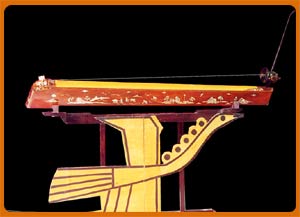|
Dan Bau (monocord)

If one sound had to be chosen
to evoke Vietnam, for many it would be the sound of the Dan Bau,
as it is one of only two traditional musical instruments of
purely Vietnamese origin.
Having the literary name of
monocord, Dan Bau is a plucked chordophone of the Viet majority.
Two popular kinds of Dan Bau are bamboo-made Dan Bau and the
wooden-sound board Dan Bau.
The bamboo-made Dan Bau is the
instrument of Xam singers (blind singers). The body of bamboo
Dan Bau is made from a bamboo tube of 120 cm length and 12 cm
diameter. The surface is formed thanks to the splitting of an
appropriate outer layer on a certain section of bamboo tube.
Wooden soundboard Dan Bau is a
variant of bamboo Dan Bau and used by professional artists.
There are a wide range of wooden Dan Bau in varying shapes and
sizes. The most popular Dan Bau has a trapezium shape and is
105-115cm long. The big end is 12cm wide and 10cm high while the
small end is 8cm wide and 7cm high. The convex surface is made
of softwood like wootung-tree wood (Ngo Dong wood) or coral-tree
wood (Vong wood). The soft-wooden bottom of the soundboard is
flat and has a sound hole. Sides and frame of the Dan Bau are
made of hard wood like rosewood or ebony.
Though the two kinds of Dan Bau
differ from each other by shapes and materials of their
soundboards, they are similar in construction.
Dan Bau in general consists of
4 components including soundboard (resonator), spout (Wammy
bar), gourd, string and tuning peg.
The spout is a piece of bamboo
or a buffalo horn that is square-framed at the root, while flat
and gradually bent at the top. The spout plays an important role
in producing sounds of different pitches beyond the fundamental
overtones (Harmonics) of the instrument.
The string runs along the body
of instrument. In the past silk string was used, now a steel
string is prefered.
The gourd is made up from a
half of a slender-necked gourd. The gourd covers the spout at
the very point where the string is attached. The gourd
contributes to increase the loudness of sound for the
instrument. Nowadays, the gourd is usually replaced with a
turned wooden ďbellĒ and therefore is only an adornment.
The tuning peg is made from
bamboo (if bamboo Dan Bau), or from wood (if wooden Dan Bau).
The tuning peg is located at the inside frame towards the bottom
of the soundboard. The string goes through a small hole at the
end of the instrument's surface and then gets through the tuning
peg. In front of such a hole is a bridge to support the string.
Most Dan Bauís now come with a
geared tuning machine.
Today, the Dan Bau is mostly
played with an electric pick up and small amplifier, so that
itís faint tone is audible in the orchestral context.
The Dan Bau is always played
with a wooden pick held in the right hand to pluck the string
while the lower side of the hand stops the string at the
appropriate node (Harmonic). The left hand moves the the spout
(wammy bar) to bend the pitch downward by moving in the
direction of the instrument, or upward by pushing the the spout
away from the instrument. The left hand also produces a variety
of vibratos, glissandos and grace notes. The instrument's
virtuosity and expressiveness are found in its left hand
technique, which should have a subtlety that mimics the sound of
the Vietnamese singing voice or traditional poetry read with
great expression.
With soft sounds, Dan Bau is
suitably used in serene context. In the past, Dan Bau was the
instrument of amature singers of Xam genre. Later though, Dan
Bau also became popular in the orchestra of Cheo genre, Tai tu
style's orchestra, and in the orchestra serving poetry reading,
in smaller ensemble or solo performance. There have been many
musical pieces exclusively composed for Dan Bau solo, such as Vu
Khuc Tay Nguyen (Dance of the Central Highland) by Duc Nhuan,
Dong kenh trong (The clear channel) by Hoang Dam, Vi Mien Nam
(for the South) by Huy Thuc, and so on.
There is a story about the Dan
Bau. Long ago, farmers went to their fields with baskets
strapped to their backs. After work, they would lie down and tie
their baskets to stalks of bamboo. The wind would blow and the
strings of the baskets would vibrate and make a sound. So people
made stringed instruments with silk threads. First they used
hollow bamboo and then later they used long dried gourds. At the
start of the 20th century, gourds were replaced with wooden
boxes.
Among many kinds of monocord of
countries all over the world, there are the Tuntina of India,
Cung of East Africa and the Tushuenkin (Xian Qin)of China .
However, none of them can produce such a popular and highly
artistic system of overtones as that of the Vietnamese Dan Bau.
Price: Professional Student
grade:$200.00 and up, plus shipment fee
Professional Artist grade:
$350.00 and up, plus shipment fee
Master grade: $500.00 and up,
plus shipment fee
CD: $15.00 each plus shipment
fee
Discountís available for larger
orders.
|





